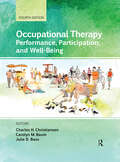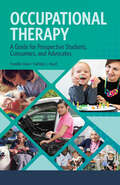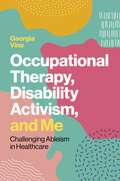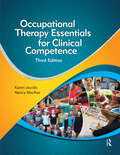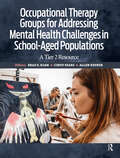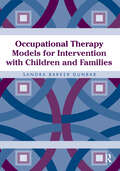- Table View
- List View
Occupational Therapy: Performance, Participation, and Well-Being
by Charles H. Christiansen Julie Bass Carolyn M. BaumOccupational Therapy: Performance, Participation, and Well-Being, Fourth Edition, is a comprehensive occupational therapy text that introduces students to core knowledge in the profession and the foundations of practice—the occupations, person factors, and environment factors that support performance, participation, and well-being. Editors, Drs. Charles H. Christiansen, Carolyn M. Baum, and Julie D. Bass, are joined by more than 40 international scholars who bring students, faculty, and practitioners the evidence that supports occupational therapy practice. The PEOP Model 4th Edition is featured as an exemplar of a person-environment-occupation model and provides a valuable roadmap for understanding key concepts and developing strong clinical reasoning skills in the occupational therapy process. Features: Examines the theories, models, frameworks, and classifications that support contemporary knowledge of person, environment, and occupational factors. Presents detailed chapters on the occupations of children and youth, adults, older adults, organizations, and populations Provides extensive coverage of the person factors (psychological, cognition, sensory, motor, physiological, spirituality) and environment factors (culture, social, physical, policy, technology) that support occupational performance Includes exceptional content on the essentials of professional practice - therapeutic use of self, evidence-based practice, professionalism, lifelong development, ethics, business fundamentals, and critical concepts Builds clear links with the AOTA’s Occupational Therapy Practice Framework, Third Edition; International Classification of Functioning, Disability and Health, and accreditation standards for entry-level occupational therapy programs. Introduces emerging practice areas of self-management, community-based practice, technology, and teaching/learning and opportunities to work with organizations and populations Incorporates international and global perspectives on core knowledge and occupational therapy practice. Documents assessments, interventions, resources, and evidence in user-friendly tables Uses simple and complex cases to illustrate key concepts and ideas. New and Updated Sections in the Fourth Edition: Individual chapters on each person factor and environmental factor and occupations across the lifespan Expanded coverage of approaches for organizations and populations and entry-level professional skills Consistent framework of tables and language across chapters and sections. Included with the text are online supplemental materials for faculty use in the classroom including PowerPoint presentations.
Occupational Therapy: Performance, Participation, and Well-Being
by Charles H. Christiansen Julie Bass Carolyn M. BaumOccupational Therapy: Performance, Participation, and Well-Being, Fourth Edition, is a comprehensive occupational therapy text that introduces students to core knowledge in the profession and the foundations of practice—the occupations, person factors, and environment factors that support performance, participation, and well-being. Editors, Drs. Charles H. Christiansen, Carolyn M. Baum, and Julie D. Bass, are joined by more than 40 international scholars who bring students, faculty, and practitioners the evidence that supports occupational therapy practice. The PEOP Model 4th Edition is featured as an exemplar of a person-environment-occupation model and provides a valuable roadmap for understanding key concepts and developing strong clinical reasoning skills in the occupational therapy process. Features: Examines the theories, models, frameworks, and classifications that support contemporary knowledge of person, environment, and occupational factors. Presents detailed chapters on the occupations of children and youth, adults, older adults, organizations, and populations Provides extensive coverage of the person factors (psychological, cognition, sensory, motor, physiological, spirituality) and environment factors (culture, social, physical, policy, technology) that support occupational performance Includes exceptional content on the essentials of professional practice - therapeutic use of self, evidence-based practice, professionalism, lifelong development, ethics, business fundamentals, and critical concepts Builds clear links with the AOTA’s Occupational Therapy Practice Framework, Third Edition; International Classification of Functioning, Disability and Health, and accreditation standards for entry-level occupational therapy programs. Introduces emerging practice areas of self-management, community-based practice, technology, and teaching/learning and opportunities to work with organizations and populations Incorporates international and global perspectives on core knowledge and occupational therapy practice. Documents assessments, interventions, resources, and evidence in user-friendly tables Uses simple and complex cases to illustrate key concepts and ideas. New and Updated Sections in the Fourth Edition: Individual chapters on each person factor and environmental factor and occupations across the lifespan Expanded coverage of approaches for organizations and populations and entry-level professional skills Consistent framework of tables and language across chapters and sections. Included with the text are online supplemental materials for faculty use in the classroom including PowerPoint presentations.
Occupational Therapy: A Guide for Prospective Students, Consumers, and Advocates
by Franklin Stein Kathlyn ReedA helpful resource that explains occupational therapy for students, clients, families, school counselors, and health professionals, Occupational Therapy: A Guide for Prospective Students, Consumers, and Advocates provides an understanding of what occupational therapists do to help people function in everyday activities. Written by esteemed authors Drs. Franklin Stein and Kathlyn L. Reed, Occupational Therapy: A Guide for Prospective Students, Consumers, and Advocates explains one of the fastest growing professions in the world. Featuring information on the specific interventions used in daily work, the educational requirements for becoming an occupational therapist, and the clinical settings where occupational therapists work, this book is the perfect introduction to the profession. Chapters are designed to educate prospective students about occupational therapy as well as the personal qualities needed to be an effective clinician. Detailed information is included with up-to-date facts great for sharing with those interested in this career. A glossary of terms at the conclusion assists students, consumers, and advocates who want to better understand the profession. Topics include: What is occupational therapy? Comparing occupational therapy to similar health professions What is the history of occupational therapy? Personal characteristics of occupational therapists Professional codes of ethics Occupational therapy clients The perfect companion book for any aspiring student or interested health professional, Occupational Therapy: A Guide for Prospective Students, Consumers, and Advocates is a great resource for all things occupational therapy.
Occupational Therapy: A Guide for Prospective Students, Consumers, and Advocates
by Franklin Stein Kathlyn ReedA helpful resource that explains occupational therapy for students, clients, families, school counselors, and health professionals, Occupational Therapy: A Guide for Prospective Students, Consumers, and Advocates provides an understanding of what occupational therapists do to help people function in everyday activities. Written by esteemed authors Drs. Franklin Stein and Kathlyn L. Reed, Occupational Therapy: A Guide for Prospective Students, Consumers, and Advocates explains one of the fastest growing professions in the world. Featuring information on the specific interventions used in daily work, the educational requirements for becoming an occupational therapist, and the clinical settings where occupational therapists work, this book is the perfect introduction to the profession. Chapters are designed to educate prospective students about occupational therapy as well as the personal qualities needed to be an effective clinician. Detailed information is included with up-to-date facts great for sharing with those interested in this career. A glossary of terms at the conclusion assists students, consumers, and advocates who want to better understand the profession. Topics include: What is occupational therapy? Comparing occupational therapy to similar health professions What is the history of occupational therapy? Personal characteristics of occupational therapists Professional codes of ethics Occupational therapy clients The perfect companion book for any aspiring student or interested health professional, Occupational Therapy: A Guide for Prospective Students, Consumers, and Advocates is a great resource for all things occupational therapy.
Occupational Therapy and Dementia: Promoting Inclusion, Rights and Opportunities for People Living With Dementia
by Helen Fisher Chris Roberts Claire Craig Katie Edwards Brendan McCormack Margaret Brown Elizabeth McKay Anthony Schrag Kate Turner Henry Rankin Lorna Noble Margaret McCallion Jayne Goodrick Anna Borthwick Neil Fullerton Sarah Kantartzis Debbie Laliberte Rudman Maria O'Reilly Ian Sherriff Fiona Fraser Toni Page Hannah Bradwell Angela Gregory Michelle Elliot Kimberley Crocker-White Lynsey Robertson Liz Copley Sophia Dickinson Alison McKean Mary McGrath Gill Gowran Ashleigh Gray Kate Keefe Cathy Piersol Jill Cigliana Kari Burch Jennifer WenbornBringing together professional and lived experience, this collection of expert voices frames dementia practice with an occupational justice lens. It provides a focus for learning and development in practice for occupational therapists and allied health workers working in dementia care, incorporating the voice of people living with dementia.
Occupational Therapy Assessments for Older Adults: 100 Instruments for Measuring Occupational Performance
by Kevin BortnickThe role of measurement and the benefits of outcome measures are defined as important tools used to document change in one or more constructs over time, help to describe a client’s condition, formulate a prognosis, as well as to evaluate the effects of occupational therapy intervention.Occupational Therapy Assessments for Older Adults: 100 Instruments for Measuring Occupational Performance presents over 100 outcome measures in the form of vignettes that encompass a brief description of each instrument, a review of its psychometric properties, its advantages and disadvantages, administration procedures, permissions to use, author contact information, as well as where and how to procure the instrument. Occupational Therapy Assessments for Older Adults by Dr. Kevin Bortnick narrows down the list of possible choices for the occupational therapy student or clinician to only those with an amount of peer review, bibliographic citations, as well as acceptance within the profession. The text also includes research-based information with text citations and has over 100 tables, diagrams, and figures. Included in the review of each outcome measure: Description: A brief record of the measure. Psychometrics: A review of the level of research evidence that either supports or does not support the instrument, including such items as inter-rater, intra-rater, and test-retest reliabilities, as well as internal consistencies and construct validities among others. Advantages: Synopsis of the benefits of using the measure over others including its unique attributes. Disadvantages: A summary of its faults. For example, the amount of research evidence may be limited or the measure may be expensive. Administration: Information regarding how to administer, score, and interpret results. Permissions: How and where to procure the instrument, such as websites where it may be purchased or journal articles or publications that may contain the scale. Summary: A brief summation of important information. Occupational Therapy Assessments for Older Adults: 100 Instruments for Measuring Occupational Performance encourages occupational therapy and occupational therapy assistants to expand their thinking about the use of appropriate outcome measures with older adult populations. Using the appropriate outcome measure based on evidence can aid in the promotion of health, well-being, and participation of clients.
Occupational Therapy Assessments for Older Adults: 100 Instruments for Measuring Occupational Performance
by Kevin BortnickThe role of measurement and the benefits of outcome measures are defined as important tools used to document change in one or more constructs over time, help to describe a client’s condition, formulate a prognosis, as well as to evaluate the effects of occupational therapy intervention.Occupational Therapy Assessments for Older Adults: 100 Instruments for Measuring Occupational Performance presents over 100 outcome measures in the form of vignettes that encompass a brief description of each instrument, a review of its psychometric properties, its advantages and disadvantages, administration procedures, permissions to use, author contact information, as well as where and how to procure the instrument. Occupational Therapy Assessments for Older Adults by Dr. Kevin Bortnick narrows down the list of possible choices for the occupational therapy student or clinician to only those with an amount of peer review, bibliographic citations, as well as acceptance within the profession. The text also includes research-based information with text citations and has over 100 tables, diagrams, and figures. Included in the review of each outcome measure: Description: A brief record of the measure. Psychometrics: A review of the level of research evidence that either supports or does not support the instrument, including such items as inter-rater, intra-rater, and test-retest reliabilities, as well as internal consistencies and construct validities among others. Advantages: Synopsis of the benefits of using the measure over others including its unique attributes. Disadvantages: A summary of its faults. For example, the amount of research evidence may be limited or the measure may be expensive. Administration: Information regarding how to administer, score, and interpret results. Permissions: How and where to procure the instrument, such as websites where it may be purchased or journal articles or publications that may contain the scale. Summary: A brief summation of important information. Occupational Therapy Assessments for Older Adults: 100 Instruments for Measuring Occupational Performance encourages occupational therapy and occupational therapy assistants to expand their thinking about the use of appropriate outcome measures with older adult populations. Using the appropriate outcome measure based on evidence can aid in the promotion of health, well-being, and participation of clients.
Occupational Therapy, Disability Activism, and Me: Challenging Ableism in Healthcare
by Georgia VineThis is a unique and important perspective on challenging ableism in healthcare from an author who is a service user, a disability activist, and an occupational therapist. Georgia Vine charts her life's journey and provides vital insight on how the education, health and social care systems need to be improved.
Occupational Therapy Disruptors: What Global OT Practice Can Teach Us About Innovation, Culture, and Community
by Sheela Roy IvlevThis anthology collates 16 unique and powerful perspectives from occupational therapists around the globe, each highlighting the culture that they are a part of and how it informs their work and care. Ranging across almost every continent in the world including stories from Aotearoa to the Gaza Strip to Dhaka and beyond, Occupational Therapy Disruptors offers a decolonised re-examination of occupational therapy through a poignant, global lens.Based on a series of interviews conducted by Sheela Roy Ivlev, each account provides candid and personal reflections and challenges found in occupational therapy in different cultural and political contexts and inspires occupational therapists to enrich their own practice with cultural awareness and reflexivity.With reflection prompts and calls to action at the end of each chapter, this is an invaluable resource for occupational therapists looking to develop a more diverse, culturally-informed understanding of their practice.
Occupational Therapy Essentials for Clinical Competence
by Karen Jacobs Nancy MacRaeOccupation, theory-driven, evidence-based, and client-centered practice continue to be the core of the profession and are the central focus of Occupational Therapy Essentials for Clinical Competence, Third Edition.The Third Edition contains updated and enriched chapters that incorporate new perspectives and evidence-based information important to entry-level practitioners. The Third Edition continues to relate each chapter to the newest ACOTE Standards and is evidence-based, while also addressing the guidelines of practice and terms from the AOTA’s Occupational Therapy Practice Framework, Third Edition.Dr. Karen Jacobs and Nancy MacRae, along with their 61 contributors, introduce every topic necessary for competence as an entry-level practitioner. Varied perspectives are provided in each chapter with consistent references made to the relevance of certified occupational therapy assistant roles and responsibilities.Additionally, chapters on the Dark Side of Occupation and Primary Care have been added to broaden the foundational scope of knowledge. Each chapter also contains a clinical case used to exemplify relevant content.New in the Third Edition: All chapters have been updated to reflect the AOTA’s Occupational Therapy Practice Framework, Third Edition Updated references and evidence-based practice chart for each chapter Updated case studies to match the current standards of practice References to the Occupational Therapy Code of Ethics (2015) Faculty will benefit from the multiple-choice questions and PowerPoint presentations that coincide with each chapter Included with the text are online supplemental materials for faculty use in the classroom.Occupational Therapy Essentials for Clinical Competence, Third Edition is the perfect multi-use resource to be used as an introduction to the material, while also serving as a review prior to sitting for the certification exam for occupational therapists and occupational therapy assistants.
Occupational Therapy Essentials for Clinical Competence
by Karen Jacobs Nancy MacRaeOccupation, theory-driven, evidence-based, and client-centered practice continue to be the core of the profession and are the central focus of Occupational Therapy Essentials for Clinical Competence, Third Edition.The Third Edition contains updated and enriched chapters that incorporate new perspectives and evidence-based information important to entry-level practitioners. The Third Edition continues to relate each chapter to the newest ACOTE Standards and is evidence-based, while also addressing the guidelines of practice and terms from the AOTA’s Occupational Therapy Practice Framework, Third Edition.Dr. Karen Jacobs and Nancy MacRae, along with their 61 contributors, introduce every topic necessary for competence as an entry-level practitioner. Varied perspectives are provided in each chapter with consistent references made to the relevance of certified occupational therapy assistant roles and responsibilities.Additionally, chapters on the Dark Side of Occupation and Primary Care have been added to broaden the foundational scope of knowledge. Each chapter also contains a clinical case used to exemplify relevant content.New in the Third Edition: All chapters have been updated to reflect the AOTA’s Occupational Therapy Practice Framework, Third Edition Updated references and evidence-based practice chart for each chapter Updated case studies to match the current standards of practice References to the Occupational Therapy Code of Ethics (2015) Faculty will benefit from the multiple-choice questions and PowerPoint presentations that coincide with each chapter Included with the text are online supplemental materials for faculty use in the classroom.Occupational Therapy Essentials for Clinical Competence, Third Edition is the perfect multi-use resource to be used as an introduction to the material, while also serving as a review prior to sitting for the certification exam for occupational therapists and occupational therapy assistants.
Occupational Therapy for Adults With Intellectual Disability
by Kimberly BryzeOccupational Therapy for Adults With Intellectual Disability provides occupational therapy practitioners and students with occupation-based solutions to serve and empower individuals with intellectual disabilities, as well as their families and caregivers, towards more self-determined, authentic lives.There are few texts that exist within occupational therapy that support this population. Dr. Kimberly Bryze and the contributing authors are all occupational therapists who have or currently provide occupational therapy services to adults with intellectual disability in various settings. They bring their expertise in scholarship and offer thoughtful, evidence-based approaches for practitioners to create change for individuals, communities, organizations, and society.This text presents an occupational perspective of individuals with intellectual disability given its focus on the following: quality of living social well-being role competence occupational identity self-advocacy occupational justice Occupational Therapy for Adults with Intellectual Disability is ideal for occupational therapy educators who teach content related to adults with intellectual and developmental disabilities, occupational therapy practitioners who provide services to adults with intellectual disability in various clinical, community, and residential settings, and occupational therapy students. Included with the text are online supplemental materials for faculty use in the classroom.The intentional, occupational focus ensures that the content is consistent with recommended practice in current occupational therapy. Occupational therapy practitioners will look to this text to provide evidence-based interventions and when developing consultative programs for persons with intellectual disability across many different settings.
Occupational Therapy for Adults With Intellectual Disability
by Kimberly BryzeOccupational Therapy for Adults With Intellectual Disability provides occupational therapy practitioners and students with occupation-based solutions to serve and empower individuals with intellectual disabilities, as well as their families and caregivers, towards more self-determined, authentic lives.There are few texts that exist within occupational therapy that support this population. Dr. Kimberly Bryze and the contributing authors are all occupational therapists who have or currently provide occupational therapy services to adults with intellectual disability in various settings. They bring their expertise in scholarship and offer thoughtful, evidence-based approaches for practitioners to create change for individuals, communities, organizations, and society.This text presents an occupational perspective of individuals with intellectual disability given its focus on the following: quality of living social well-being role competence occupational identity self-advocacy occupational justice Occupational Therapy for Adults with Intellectual Disability is ideal for occupational therapy educators who teach content related to adults with intellectual and developmental disabilities, occupational therapy practitioners who provide services to adults with intellectual disability in various clinical, community, and residential settings, and occupational therapy students. Included with the text are online supplemental materials for faculty use in the classroom.The intentional, occupational focus ensures that the content is consistent with recommended practice in current occupational therapy. Occupational therapy practitioners will look to this text to provide evidence-based interventions and when developing consultative programs for persons with intellectual disability across many different settings.
Occupational Therapy Groups for Addressing Mental Health Challenges in School-Aged Populations: A Tier II Resource
by Brad Egan Cindy Sears Allen KeenerA new resource for school-based occupational therapists, Occupational Therapy Groups for Addressing Mental Health Challenges in School-Aged Populations: A Tier 2 Resource is a collection of occupation-based group interventions and tools that can be used to support students at risk for or with identified mental health challenges.School-wide mental health programs are increasing and expanding. School-based occupational therapists are uniquely positioned to collaborate with traditional school mental health practitioners and provide an occupational perspective on how mental health can impact school performance and participation in academic occupations.Occupational Therapy Groups for Addressing Mental Health Challenges in School-Aged Populations is organized into different sections to assist the occupational therapy practitioner or occupational therapy student in considering different aspects of providing mental health services in schools. The text serves as a flexible compendium of group activities and interventions designed to promote positive mental health for all students and support students at risk for or with identified mental health challenges.What’s included in Occupational Therapy Groups for Addressing Mental Health Challenges in School-Aged Populations: Cases to help recognize the occupational impact of internalizing and externalizing behaviors A quick reference of common assessments and screening tools Occupation-based Tier 2 group protocols and data collection tool templates An online section for occupational therapy and occupational therapy assistant educators with ideas for learning assignments, rubrics, and classroom activities to prepare prelicensure learners for addressing school mental health needs once they enter practice Occupational Therapy Groups for Addressing Mental Health Challenges in School-Aged Populations: A Tier 2 Resource expresses the valued contribution that occupational therapists make to school mental health initiatives while also addressing a major gap—a Tier 2–focused resource with intervention ideas and tools for answering this urgent call to practice.
Occupational Therapy Groups for Addressing Mental Health Challenges in School-Aged Populations: A Tier II Resource
by Brad Egan Cindy Sears Allen KeenerA new resource for school-based occupational therapists, Occupational Therapy Groups for Addressing Mental Health Challenges in School-Aged Populations: A Tier 2 Resource is a collection of occupation-based group interventions and tools that can be used to support students at risk for or with identified mental health challenges.School-wide mental health programs are increasing and expanding. School-based occupational therapists are uniquely positioned to collaborate with traditional school mental health practitioners and provide an occupational perspective on how mental health can impact school performance and participation in academic occupations.Occupational Therapy Groups for Addressing Mental Health Challenges in School-Aged Populations is organized into different sections to assist the occupational therapy practitioner or occupational therapy student in considering different aspects of providing mental health services in schools. The text serves as a flexible compendium of group activities and interventions designed to promote positive mental health for all students and support students at risk for or with identified mental health challenges.What’s included in Occupational Therapy Groups for Addressing Mental Health Challenges in School-Aged Populations: Cases to help recognize the occupational impact of internalizing and externalizing behaviors A quick reference of common assessments and screening tools Occupation-based Tier 2 group protocols and data collection tool templates An online section for occupational therapy and occupational therapy assistant educators with ideas for learning assignments, rubrics, and classroom activities to prepare prelicensure learners for addressing school mental health needs once they enter practice Occupational Therapy Groups for Addressing Mental Health Challenges in School-Aged Populations: A Tier 2 Resource expresses the valued contribution that occupational therapists make to school mental health initiatives while also addressing a major gap—a Tier 2–focused resource with intervention ideas and tools for answering this urgent call to practice.
Occupational Therapy Interventions: Function and Occupations
by Catherine Meriano Donna LatellaOccupational Therapy Interventions: Functions and Occupations, Second Edition is a unique and comprehensive text intended to provide the essential information required for occupational therapy practice in the physical approach to the intervention process. This practical and user-friendly text offers an entry-level approach to bridging the American Occupational Therapy Association’s Occupational Therapy Practice Framework,Third Edition with everyday practice, specifically concerning interventions.Dr. Catherine Meriano and Dr. Donna Latella focus each chapter of the text on an area of occupation, evidence-based practice, current intervention options, as well as a specific hands-on approach to grading interventions. Although the focus of the text is the intervention process, Occupational Therapy Interventions: Function and Occupations, Second Edition also includes a detailed “Evaluation Grid” which offers a unique approach to choosing occupational therapy evaluations.New in the Second Edition: New evidence-based articles have been added to each of the chapters Some new rewritten and expanded chapters Updated references throughout Includes sample exam questions with each chapter Updated key concepts and incorporated new documents such as: AOTA’s Occupational Therapy Practice Framework,Third Edition AOTA’s Occupational Therapy Code of Ethics AOTA’s Guidelines for Supervision, Roles, and Responsibilities During the Delivery of Occupational Therapy Services Included with the text are online supplemental materials for faculty use in the classroom.With the incorporation of new evidence-based concepts, updates to reflect the AOTA’s newest documents, and new hands-on approaches to interventions, Occupational Therapy Interventions: Functions and Occupations, Second Edition should be by the side of every occupational therapy student and entry-level practitioner.
Occupational Therapy Interventions: Function and Occupations
by Catherine Meriano Donna LatellaOccupational Therapy Interventions: Functions and Occupations, Second Edition is a unique and comprehensive text intended to provide the essential information required for occupational therapy practice in the physical approach to the intervention process. This practical and user-friendly text offers an entry-level approach to bridging the American Occupational Therapy Association’s Occupational Therapy Practice Framework,Third Edition with everyday practice, specifically concerning interventions.Dr. Catherine Meriano and Dr. Donna Latella focus each chapter of the text on an area of occupation, evidence-based practice, current intervention options, as well as a specific hands-on approach to grading interventions. Although the focus of the text is the intervention process, Occupational Therapy Interventions: Function and Occupations, Second Edition also includes a detailed “Evaluation Grid” which offers a unique approach to choosing occupational therapy evaluations.New in the Second Edition: New evidence-based articles have been added to each of the chapters Some new rewritten and expanded chapters Updated references throughout Includes sample exam questions with each chapter Updated key concepts and incorporated new documents such as: AOTA’s Occupational Therapy Practice Framework,Third Edition AOTA’s Occupational Therapy Code of Ethics AOTA’s Guidelines for Supervision, Roles, and Responsibilities During the Delivery of Occupational Therapy Services Included with the text are online supplemental materials for faculty use in the classroom.With the incorporation of new evidence-based concepts, updates to reflect the AOTA’s newest documents, and new hands-on approaches to interventions, Occupational Therapy Interventions: Functions and Occupations, Second Edition should be by the side of every occupational therapy student and entry-level practitioner.
Occupational Therapy Models for Intervention with Children and Families
by Sandra DunbarOccupational Therapy Models for Intervention with Children and Families explores recent theoretical models that enable occupational therapists to practice and interact with families in a more holistic and occupation-centered manner. This comprehensive and dynamic text offers the latest information on viewing the broader contexts of environment and family in order to meet diverse occupational needs in a range of settings.Sandra Barker Dunbar presents a variety of case scenarios that feature culturally diverse populations and varying diagnoses of children with occupational needs. With contributions from 11 renowned leaders in occupational therapy, this comprehensive text is designed to increase awareness and understanding of theoretical models and their relationship to current occupational therapy practice with today’s children and families.Inside Occupational Therapy Models for Intervention with Children and Families, traditional frames of reference in pediatric practice are explored, including sensory integration and neurodevelopmental treatment. Some current theoretical models discussed include the Model of Human Occupation, the Person-Environment-Occupation model, the Ecology of Human Performance model, and the Occupational Adaptation model. The new Occupational Therapy Practice Framework is incorporated throughout the text.Employing a practical approach to this significant aspect of pediatric practice in occupational therapy, Occupational Therapy Models for Intervention with Children and Families is an invaluable tool for students at all curriculum levels.
Occupational Therapy Models for Intervention with Children and Families
by Sandra DunbarOccupational Therapy Models for Intervention with Children and Families explores recent theoretical models that enable occupational therapists to practice and interact with families in a more holistic and occupation-centered manner. This comprehensive and dynamic text offers the latest information on viewing the broader contexts of environment and family in order to meet diverse occupational needs in a range of settings.Sandra Barker Dunbar presents a variety of case scenarios that feature culturally diverse populations and varying diagnoses of children with occupational needs. With contributions from 11 renowned leaders in occupational therapy, this comprehensive text is designed to increase awareness and understanding of theoretical models and their relationship to current occupational therapy practice with today’s children and families.Inside Occupational Therapy Models for Intervention with Children and Families, traditional frames of reference in pediatric practice are explored, including sensory integration and neurodevelopmental treatment. Some current theoretical models discussed include the Model of Human Occupation, the Person-Environment-Occupation model, the Ecology of Human Performance model, and the Occupational Adaptation model. The new Occupational Therapy Practice Framework is incorporated throughout the text.Employing a practical approach to this significant aspect of pediatric practice in occupational therapy, Occupational Therapy Models for Intervention with Children and Families is an invaluable tool for students at all curriculum levels.
Occupational Therapy Student to Clinician: Making the Transition
by Lisa Davis Marilyn RoseeIt is surprising that there is no “go-to” resource for the occupational therapy or occupational therapy assistant student to have when they embark on their professional journey. With this in mind, Lisa Davis and Marilyn Rosee have written Occupational Therapy Student to Clinician: Making the Transitionto help students hone the skills employers look for in new hires. While many academic programs cover career-oriented topics, this is the first specific text to pull the pieces together with the purpose of showing readers how to become successful job candidates and employees. Perfect for the student preparing for an occupational therapy career, Occupational Therapy Student to Clinician covers all pragmatic issues that students face while securing their first job. This text outlines a variety of topics including résumé writing, interview skills, negotiating a salary, working within a team, developing professional competencies, and understanding the culture of an organization. Each chapter includes learning objectives and lists of practice activities that students can use to reinforce their skills.Occupational Therapy Student to Clinician: Making the Transition will benefit occupational therapy and occupational therapy assistant students preparing to graduate, as well as employed clinicians dealing with specific employment-related issues. This text will also guide the employee who wants to move to the next job and reacquaint themselves with the job-seeking process. This comprehensive resource provides strategies and solutions for many employment challenges and will be an asset in any professional development curriculum.
Occupational Therapy Student to Clinician: Making the Transition
by Lisa Davis Marilyn RoseeIt is surprising that there is no “go-to” resource for the occupational therapy or occupational therapy assistant student to have when they embark on their professional journey. With this in mind, Lisa Davis and Marilyn Rosee have written Occupational Therapy Student to Clinician: Making the Transitionto help students hone the skills employers look for in new hires. While many academic programs cover career-oriented topics, this is the first specific text to pull the pieces together with the purpose of showing readers how to become successful job candidates and employees. Perfect for the student preparing for an occupational therapy career, Occupational Therapy Student to Clinician covers all pragmatic issues that students face while securing their first job. This text outlines a variety of topics including résumé writing, interview skills, negotiating a salary, working within a team, developing professional competencies, and understanding the culture of an organization. Each chapter includes learning objectives and lists of practice activities that students can use to reinforce their skills.Occupational Therapy Student to Clinician: Making the Transition will benefit occupational therapy and occupational therapy assistant students preparing to graduate, as well as employed clinicians dealing with specific employment-related issues. This text will also guide the employee who wants to move to the next job and reacquaint themselves with the job-seeking process. This comprehensive resource provides strategies and solutions for many employment challenges and will be an asset in any professional development curriculum.
OCD and Autism: A Clinician's Guide to Adapting CBT
by Amita Jassi Ailsa Russell Kate JohnstonResearch has shown that standard CBT protocols for OCD are less effective for people with autism. Based on current research and evidence this book shows how to adapt CBT approaches for comorbid OCD and autism, with step-by-step guidance and accompanying tools and worksheets available to download.
Ocean - The Secret of Planet Earth
by Carlos M. DuarteThe ocean characterises planet Earth and differentiates it from the more than 5000 known planets. It is also the habitat where life emerged as a singularity in the universe. However, we know less about the oceans than we do about some remote planets such as Mars.This book provides basic facts for understanding the oceans, their properties and their importance to mankind through the ages. The long relationship between the ocean and humanity, which permeates all areas of our culture, is at a crossroads where human activity is profoundly affecting its functioning and the integrity of marine ecosystems. However, the intelligent and rational use of the ocean holds, in large part, the key to providing the resources needed to sustain our quality of life in the future. Unlocking, through scientific research, the secrets that the ocean still holds is an essential challenge for humanity. This book informs the reader about all these aspects of the ocean through a text that combines scientific rigour with personal reflections based on the author's own experiences, dedicated to exploring and learning more about the ocean.
Oceanographic and Marine Environmental Studies around the Arabian Peninsula
by Najeeb M.A. Rasul Ian C.F. StewartOceanographic and Marine Environmental Studies around the Arabian Peninsula presents studies on a range of topics related to the marine environment of the Red Sea and Arabian (Persian) Gulf. This book contains invited and peer-reviewed chapters from diverse researchers active in their respective fields. The chapters offer new data and include comprehensive lists of references. Some of the main topics included in the book are pollution from heavy metals and petroleum, hydro-environmental characteristics of the seas, conservation of marine ecosystems, the risk of climate change on the Red Sea region, and the mangrove environment. With new developments occurring in the coastal regions in recent decades, the book will be not only a helpful resource to researchers but also a valuable reference for anyone curious about managing the marine and littoral environment of these two unique seas.
Oceanography and Marine Biology: An annual review. Volume 53 (ISSN #57)
by A. C. Dale I. P. Smith R. N. Hughes D. J. HughesThe book examines basic areas of marine research, subjects of special and topical importance; and new areas as they arise. This series is consistently among the highest ranking in terms of impact factor in the marine biology category of the citation indices compiled by the Institute of Scientific Information. It is an essential reference for research workers and students in all fields of marine science, and the series volumes find a place in the libraries of universities, marine laboratories, research institutes and government departments.
